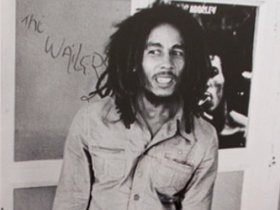About the exhibition: The exhibition features 28 intimate portraits and live shots of Bob Marley in black and white and color taken by Dennis Morris and new collabrative work by Shepard Fairey and Dennis Morris.
Burnin'
 "I call this one 'Burnin''," Morris says of the trio of images at left. "That was from that early tour – we were sitting together, and he said, 'Let me show you how to smoke a spliff, Dennis." He laughs. "That was my initiation."
"I call this one 'Burnin''," Morris says of the trio of images at left. "That was from that early tour – we were sitting together, and he said, 'Let me show you how to smoke a spliff, Dennis." He laughs. "That was my initiation."
Babylon by Van

This is the first photo Morris took of Marley, back in 1974, in the singer's Ford Transit tour van. "When you're looking at it, he's just turning towards the seat I'm sitting in," he says. "He just turned around and said, 'You ready, Dennis?' I got in there and the adventure began."
Backstage
"This is from that first tour, in Bournemouth," Morris says. "He was one of the first Jamaican musicians to understand the power of images. Most Jamaican musicians were never interested in photos – just making a record and getting paid. Bob understood the power of the image and what that could do. And I think he realized that I could get what he wanted to portray."
King's Road This photo dates from around 1979, when Marley was staying on King's Road in Chelsea, London. "He was at the height of his powers," Morris says. "You can see the vibrancy. The thing about Bob, to me, was that he had an incredible sense of being – his presence was enormous. He knew exactly what he was there for; what he was about; the power of his music; the power of himself; the power he tried to instill into people, what people could do if they believe in themselves. The man truly was a messenger." Adds Morris, "One of the things that most people don't realize is that the rise of his success was four years: He really took off in '77, and by '81 he was gone. In four years, he conquered the world. He touched every single human being possible in such a short amount of time. It was an incredible feat."
This photo dates from around 1979, when Marley was staying on King's Road in Chelsea, London. "He was at the height of his powers," Morris says. "You can see the vibrancy. The thing about Bob, to me, was that he had an incredible sense of being – his presence was enormous. He knew exactly what he was there for; what he was about; the power of his music; the power of himself; the power he tried to instill into people, what people could do if they believe in themselves. The man truly was a messenger." Adds Morris, "One of the things that most people don't realize is that the rise of his success was four years: He really took off in '77, and by '81 he was gone. In four years, he conquered the world. He touched every single human being possible in such a short amount of time. It was an incredible feat."
Football
"Here he is on a shopping spree," Morris says of this image from his first tour with Marley in 1974. "Whenever he had time off, what'd he always do was go to a sports shop and buy 20 footballs, 20 pairs of boots and whatever. I didn't realize, but it was for the kids in Trench Town, back home. He was a very generous man."
Slave Driver "This is the first live shot I took of him," says Morris. "It was at the Speak Easy Club. That I call 'Slave Driver': 'Ev'rytime I hear the crack of a whip/My blood runs cold/I remember on the slave ship/How they brutalize the very souls.' He almost looks like a soul singer, a blues singer, to me."
"This is the first live shot I took of him," says Morris. "It was at the Speak Easy Club. That I call 'Slave Driver': 'Ev'rytime I hear the crack of a whip/My blood runs cold/I remember on the slave ship/How they brutalize the very souls.' He almost looks like a soul singer, a blues singer, to me."
To see more shots and read the stories behind each check out Rolling Stones Magazine here!













 less
less
 more
more